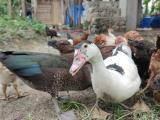Apr 13, 2010 (CIDRAP News) – Two patients who are part of a suspected H5N1 avian influenza case cluster in northern Vietnam's Bac Kan province are still hospitalized, with 11 others isolated for flu-like symptoms, health officials said today.
The two hospitalized patients include a 22-year-old man and a 27-month-old girl whose confirmed infections were previously reported by the Vietnamese media, the Associated Press (AP) reported today.
Hoang Van Linh, deputy director of northern Bac Kan's health department, told the news service that some of the isolated group includes relatives of the two hospitalized patients. Hoang said the 11 people in isolation recovered after treatment with oseltamivir (Tamiflu) and that he is awaiting test results to see if any were infected with the H5N1 virus.
The man was hospitalized on Apr 2 and remains under care, and the toddler, admitted Apr 4, is in stable condition, he told the AP.
FluTrackers, an Internet message board that translates foreign-language news reports on infectious disease events, has been following local coverage of the suspected cluster for the past several days. Though FluTrackers and other infectious disease blogs warn readers to interpret translated reports with caution, they have noted that most of the information coming out of Vietnam about the cluster has been consistent.
Vietnam's health ministry, in a Web posting, said dead chickens were reported at the homes of the two hospitalized patients and that the toddler's family reportedly slaughtered and ate some of the infected poultry, according to the AP report. A provincial infectious disease official told the AP that all of the isolated patients had contact with sick birds.
Bac Kan province, a mountainous area in northern Vietnam, was among two areas cited in H5N1 outbreak reports that the country's agriculture ministry submitted to the World Organization for Animal Health (OIE) on Apr 10. The outbreak in Bac Kan started on Mar 19, killing 318 of 550 birds in the affected village. The remaining 142 birds were destroyed to control the spread of the virus.
The country also reported that the virus struck birds in a village in Quang Ninh province, located on Vietnam's northeastern coast, killing 1,231 of 1,554 birds. The remaining poultry were destroyed.
An investigation into the source of the events suggested that introduction of new animals, illegal movement of birds, and fomites were linked to the two H5N1 outbreaks, the OIE report said.
Geographic and family H5N1 clusters are relatively rare, and they raise fears that the virus has improved its ability to infect humans, which could increase the risk that the virus could become a pandemic flu strain.
For example, a cluster of confirmed and suspected H5N1 cases occurred in northwestern Pakistan in late 2007. The World Health Organization (WHO) investigation revealed that the virus probably spread among four brothers and went no further.
Also in late 2007 the father of a Chinese man who died of an H5N1 infection was hospitalized with H5N1 avian flu. Reports at the time were unclear about the men's exposure to sick and dead birds.
Despite periodic reports of clusters, human-to-human transmission of the H5N1 virus, though suspected in some instances, has been confirmed in the laboratory only once, in a North Sumatra, Indonesia, family in 2006. The cluster involved seven cases, six of them fatal. A WHO investigation into the illnesses revealed that the virus mutated slightly when it infected a 10-year-old boy, who then passed the same virus to his father.
See also:
FluTrackers suspected Vietnam case cluster thread
Apr 10 OIE report
Apr 9 CIDRAP News story "WHO confirms Egyptian H5N1 death, Vietnam probes possible cluster"
Jun 26, 2006, CIDRAP News story "H5N1 mutation showed human transmission in Indonesia"



















